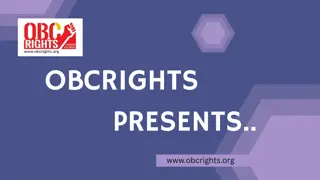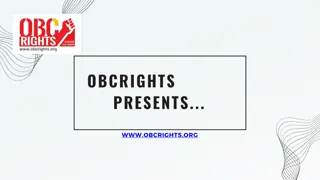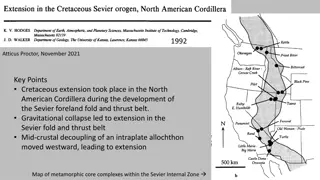Extension Scholarship in Problem-Solving at LGUs
Practice scholarship of extension at LGUs by defining issues and problems, translating, integrating, and applying knowledge to find solutions.
Download Presentation

Please find below an Image/Link to download the presentation.
The content on the website is provided AS IS for your information and personal use only. It may not be sold, licensed, or shared on other websites without obtaining consent from the author.If you encounter any issues during the download, it is possible that the publisher has removed the file from their server.
You are allowed to download the files provided on this website for personal or commercial use, subject to the condition that they are used lawfully. All files are the property of their respective owners.
The content on the website is provided AS IS for your information and personal use only. It may not be sold, licensed, or shared on other websites without obtaining consent from the author.
E N D
Presentation Transcript
The scholarship of extension: Translating, integrating, and applying knowledge to solve a problem. At LGUs, we practice this scholarship by: Defining an issue or problem. Identifying and engaging clientele. Non-formal teaching (many options). Measuring outcomes and impacts.
You understand your position, your clientele, and how you fit in the Extension Roadmap. You ve developed clientele relationships. You ve become an example to others learning extension.
Youre focusing on medium/long-term outcomes and impacts the Targeting the Outcomes of Programs (TOP model). You have your favorite methods of teaching clientele. You re trying to measure changes in knowledge, skills, practices, and behavior. Your impacts are social, economic, or environmental (SEE).
R/E, for example: Field research becomes field days. Research papers inspire EDIS documents. T/E, for example: Course material becomes extension publications. Formal courses flipped to Extension online. (https://ifas.catalog.instructure.com/)
Review descriptions of job duties, goals, and connection to the Extension Roadmap. Refine the nature and description of your program(s). Check your logic models. How can they be improved? https://edis.ifas.ufl.edu/wc106 Be clear, concise, and impactful!
Program title. Situation statement. Target audience(s). Objectives. Educational methods and activities. Outcomes and impacts that address the objectives.
Too general: Vegetable crop irrigation Food entrepreneurship More specific: Increasing the knowledge and adoption of sustainable irrigation practices for water conservation by the vegetable industry Rural economic development through food entrepreneurship
https://edis.ifas.ufl.edu/pd010 A brief and to-the-point overview of the program rationale. Why is this important? Who cares? What is the intended outcome or impact? (The SEE conditions.) Make it easy to understand.
Who are you teaching? Examples: Extension agents. Farmers/growers/producers. Industry. Consultants. State/federal agencies. Government officials. Homeowners/HOAs. General public.
https://edis.ifas.ufl.edu/fy1327 Brief and to-the-point statements of the major intended outcomes of the program. (SEE conditions.) Specific, Measurable, Attainable, Realistic, Timed. Change in knowledge, behavior, management practices, economic status, etc. (KASA) Obvious link to the situation statement.
How did you teach your target audiences/clientele? (Quantify) One-on-one. Group learning (workshops, field days, etc.). In-service training (for county faculty). Creative works (web pages, slide sets, apps). Publications (journal articles, EDIS, popular articles, etc.) Social media (podcasts, blogs, tweets). ANY OF THESE CAN BE ONLINE.
Be as clear and quantitative as possible. What happened? Participation. (Count) KASA Knowledge increase. (Test) KASA Behavior/practice change. (Survey) SEE benefits. (Synthesize) Answer the So what? question. For more details on program evaluation, see Dr. Harder s material.
Title, situation, audiences, objectives are essentially the same. Educational methods and activities. Broader suite of activities, including innovative methods. Extension scholarship is wider and deeper. Show leadership as well as participation.
Outcomes and impacts. Show a broader reach, e.g., going from regional to statewide or beyond. Your extension scholarship is being used by others; you have developed a following. Achieve medium to long-term objectives: awareness/knowledge gain led to practice change that led to a SEE condition (and you have some data to prove or infer it). Highlight success stories.
Show significant extension activities that do not fit within your logic models. Advisory committee work. Community education effort. Science communication. Work with youth.
13. Contribution to discipline 14. Creative works 16. Publications (like EDIS) 17. Professional presentations 18. Sponsored projects; revenue 24. Extension programs 28. Honors
Briefly describe how your research and/or teaching programs have motivated you to pursue extension/outreach activities. Who are the activities directed to-describe your stakeholders. Describe educational/outreach outputs including EDIS publications, industry magazine articles or other extension educational materials. Describe educational/outreach activities including presentations at stakeholder group meetings, workshops, field demos & other extension events. Do not leave blank or write N/A in Section 24.
Write your story and own it. Use the entire packet. Internal consistency is powerful it reinforces major themes. Build your brand, credibility, vision, and mission. Understand your audience and don t make them read between the lines. Document impact.
Facts are your friend. You are addressing the most important issues in our state and country. You are an expert and trusted resource. The work you do affects how many people? affects state resource use, policy, health? affects the economy how much? You bring people together and work in teams What is your role?
Mentoring committee. Use your 3- year review. Dr. Maia McGuire APL Sea Grant Dr. Karla Shelnutt SPL Nutrition Dr. Shirley Baker APL Nat Resources Extension Admin team. Dr. Saqib Mukhtar Associate Dean/SPL Agriculture/Natural Resources/Sea Grant























